
Autism and Motor Skills
Deciphering Motor Challenges in Autism Spectrum Disorder
Exploring the Intersection of Autism and Motor Function
Motor difficulties are a predominant feature in autism spectrum disorder (ASD), affecting a significant proportion of individuals across their lifespan. These challenges encompass a broad range of issues from infancy through adulthood, profoundly impacting daily living, social participation, and overall development. This article delves into the neurological underpinnings, assessment methods, and intervention strategies related to motor skills in autism, emphasizing the importance of early detection and targeted therapy for improving quality of life.
Prevalence and Early Signs of Motor Difficulties in Autism
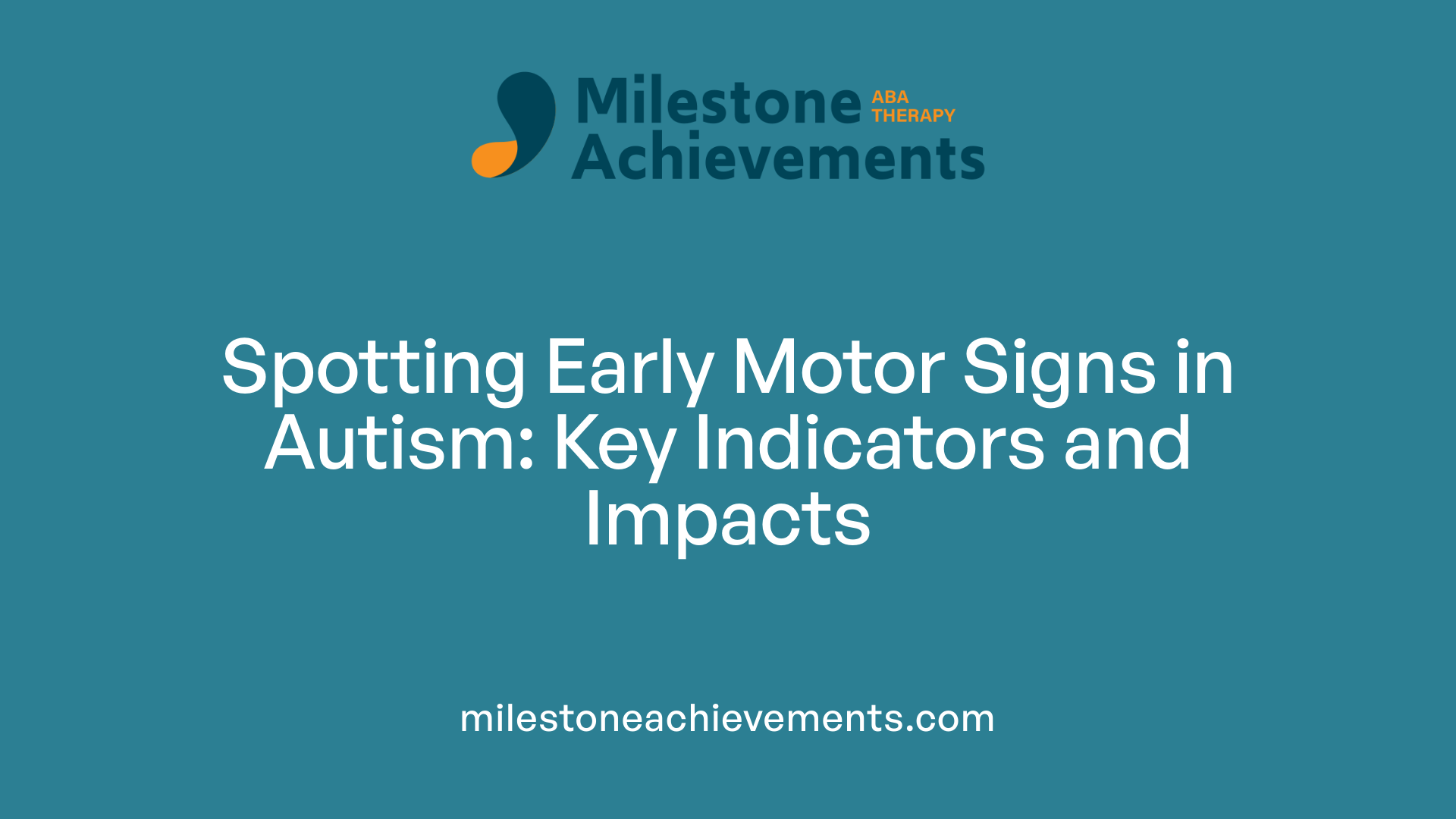
What is the relationship between autism and motor skills development and impairments?
Autism is frequently linked to various motor development challenges, affecting both gross and fine motor skills. Studies indicate that between 50% and 95% of autistic individuals experience motor difficulties at some point in their lives.
These challenges often begin in early childhood, sometimes evident in infancy. Signs such as limited arm movement, head flopping when pulled into sitting positions, and delays in milestones like crawling, walking, grasping, and sitting up are common. These initial signs can be subtle but signal underlying neurodevelopmental differences.
Motor problems tend to persist through adulthood, impacting balance, coordination, and fine motor tasks such as handwriting and self-care. These issues are linked to differences in brain connectivity, including decreased communication between sensory and motor areas, along with sensory processing differences and muscle tone abnormalities.
Underlying causes also involve genetic factors and brain wiring differences, contributing to atypical movement patterns and coordination issues. For example, mutations related to syndromic forms like Phelan-McDermid syndrome are associated with specific motor impairments.
Motor impairments can interfere with daily activities, academic achievement, and social participation. They may also limit exploration and physical activity, further affecting development and health.
Despite their prevalence, motor difficulties in autism are often under-recognized. Early identification and intervention—such as physical and occupational therapy—are crucial for improving motor skills.
Addressing motor issues alongside other developmental areas can enhance overall functioning, support communication, and foster social engagement, ultimately improving quality of life for autistic individuals.
This emphasizes the importance of comprehensive assessments and targeted therapies early in development to support motor growth and related skills.
Types of Motor Difficulties in Autism
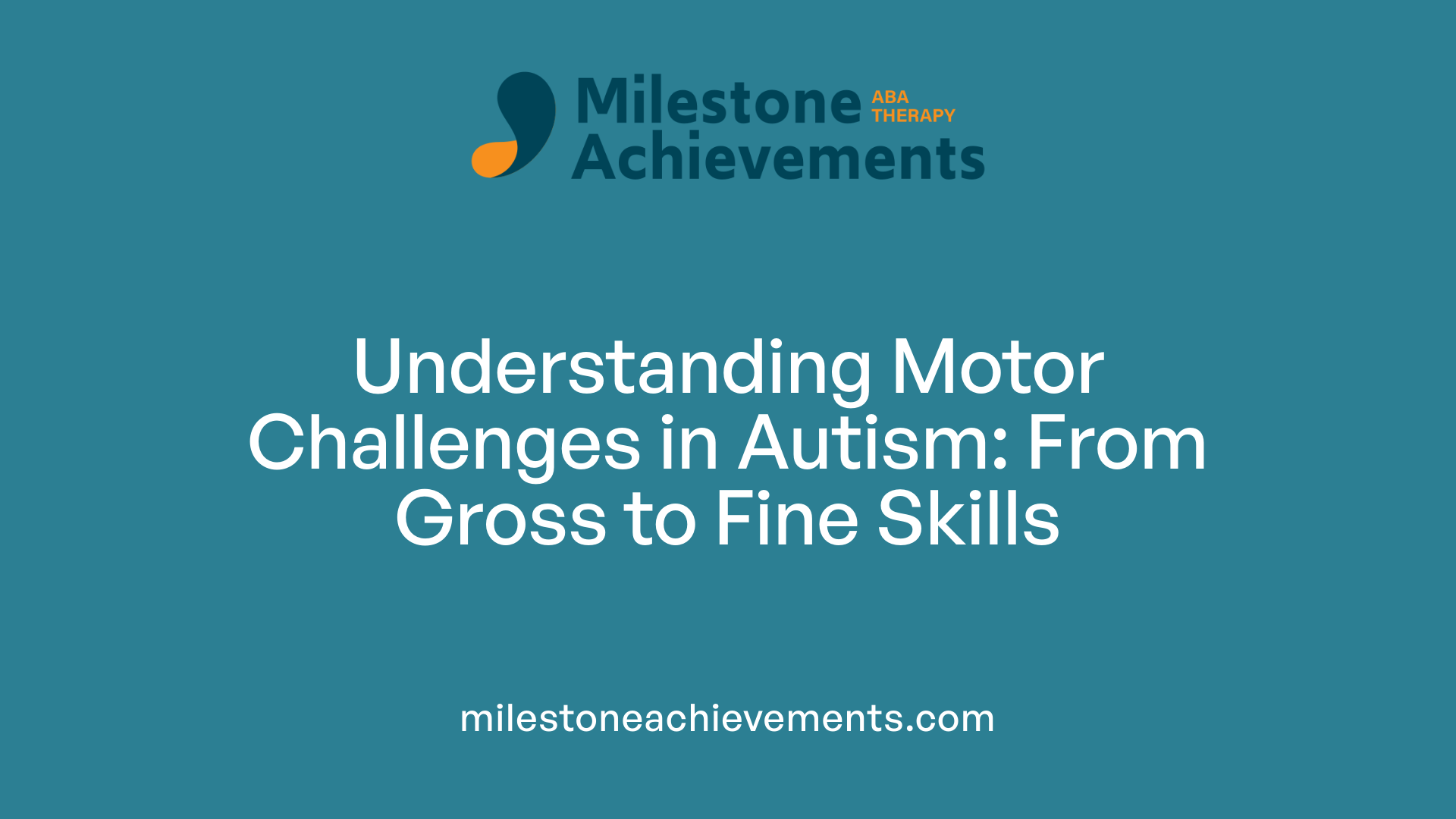
What types of motor difficulties are associated with autism?
Autism commonly involves a range of motor challenges that can affect many aspects of movement and coordination. These difficulties are often apparent early in life and can persist into adulthood, influencing daily function, social interaction, and health.
One prevalent issue involves gross motor skills—large movements like walking, running, jumping, and maintaining balance. Many autistic children experience delays in achieving these milestones, and difficulties with coordination and postural control are common. For example, problems with balance and narrow or unsteady gait can increase the risk of falls and hinder participation in physical activities.
Fine motor skills, which include hand and finger movements necessary for activities like handwriting, buttoning, and manipulating objects, are also frequently impaired. Challenges in hand-eye coordination, motor planning, strength, and finger dexterity can make self-care tasks and learning to write more difficult. These problems are often linked to issues in sensory-motor integration and brain connectivity.
Motor stereotypies—repetitive, rhythmic movements such as hand-flapping, rocking, or spinning—are characteristic behaviors that can be mistaken for motor impairments but are also seen as a form of motor self-stimulation or regulation.
Balance and postural control difficulties are common, often related to atypical development in cerebellar regions responsible for coordination. These issues can contribute to poor motor timing and spatial awareness, affecting everything from balance on one leg to complex movements required in sports or play.
Sensorimotor coordination—the ability to integrate sensory inputs with motor actions—is another area affected in autism. Difficulties here can manifest as problems with hand-eye coordination, spatial awareness, and executing movements based on sensory feedback.
Overall, these motor challenges are highly prevalent, with estimates suggesting that up to 87% of autistic children experience some form of motor difficulty. Recognizing and addressing these impairments through therapies like occupational and physical therapy can significantly improve functioning and quality of life.
Neurological Foundations of Motor Challenges in Autism
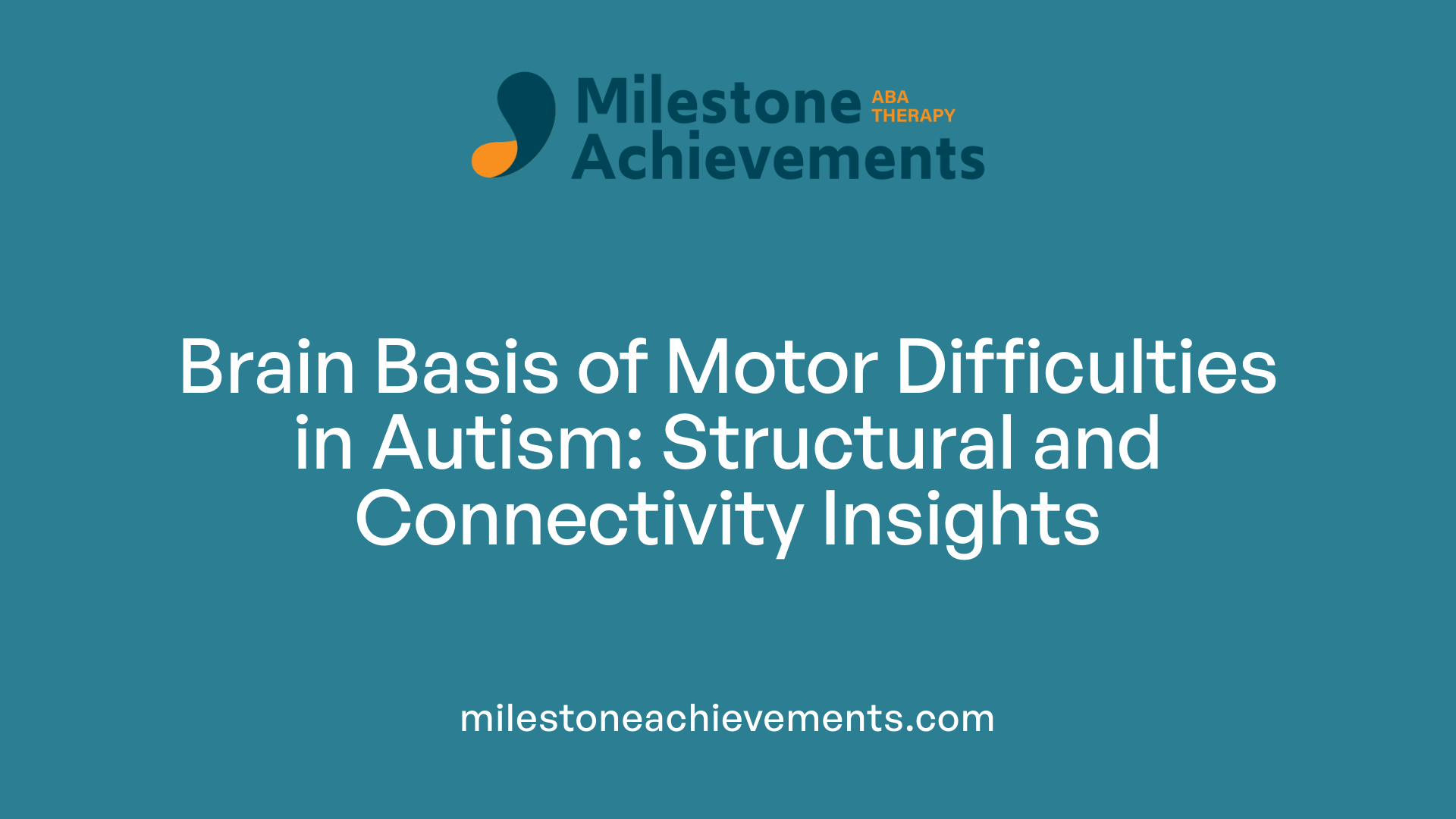
What are the neurological causes of motor deficits in autism?
Autism-related motor difficulties are rooted in differences in brain structure and connectivity. One significant contributor is the cerebellum, a brain region essential for coordination, balance, and precise motor control. Studies have found reduced volume in cerebellar regions like lobules VI and VIII, which correlates with motor coordination issues in autistic individuals.
Beyond the cerebellum, disrupted neural pathways between various cortical and subcortical areas contribute to motor impairments. Atypical connectivity between the motor cortex, basal ganglia, and cerebellum impairs processes like motor learning, praxis (the ability to plan and execute coordinated movements), and gait. These disruptions can manifest as unsteady gait, fine motor issues like handwriting problems, and delayed motor milestones.
Mirror neuron system (MNS) dysfunction may also influence motor skills. The MNS is involved in imitation and understanding others’ actions, which are critical in social interaction and motor learning. Deficits here can lead to difficulties in mimicking gestures or movements, affecting communication and social engagement.
Neuroimaging research provides further insight. Techniques like MRI have revealed decreased white matter volume in motor-related regions and abnormal activation during motor tasks. These findings suggest that the neural pathways necessary for smooth, coordinated movements are compromised.
Genetic factors associated with autism and syndromic forms, such as Phelan-McDermid syndrome and dup15q syndrome, are linked to specific motor difficulties like low muscle tone and abnormal gait patterns. Overall, structural and functional brain differences in autism underlie the motor challenges observed from infancy through adulthood.
Motor Impairments and Developmental Trajectories
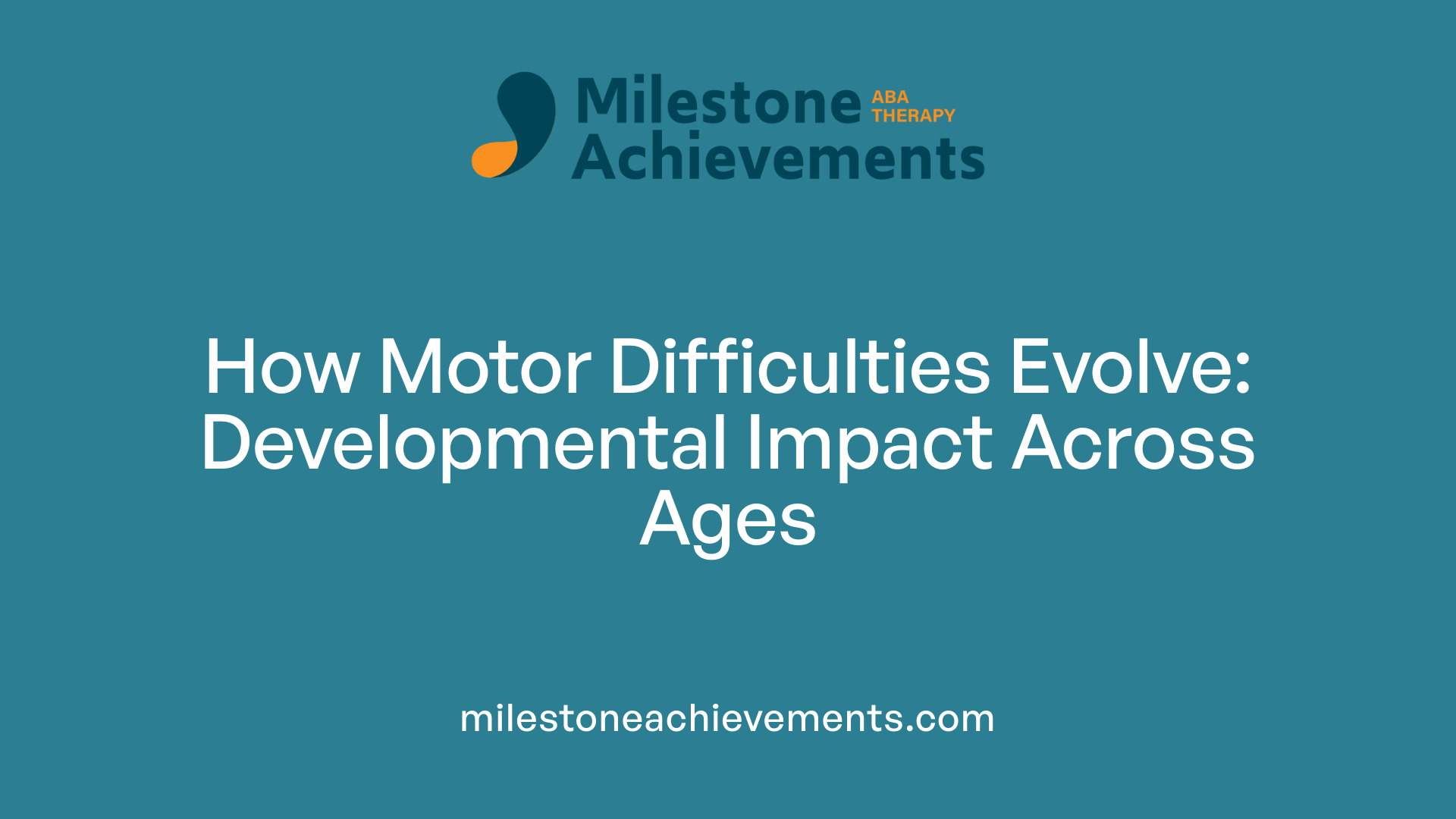
How do motor impairments affect individuals with autism across different age groups?
Motor difficulties are prevalent in autistic individuals across all life stages, impacting their daily functioning and participation in social and physical activities. In early childhood, many children with autism show signs of motor delays, such as late achievement of milestones like sitting up, crawling, and walking. These early signs can serve as important markers for early detection of autism.
As children grow, these motor challenges often persist, affecting their coordination, balance, and gait. For example, issues with posture, unsteady gait, and fine motor skills like handwriting and dressing are common. These difficulties can hinder exploration and social engagement, limiting opportunities for interaction and learning.
In adolescence and adulthood, motor problems continue to influence independence and quality of life. Adults with autism often exhibit balance issues, slower walking speeds, and coordination deficits, which may increase fall risk and reduce participation in hobbies, sports, or employment activities.
Despite the high occurrence—up to 97% in observational studies and 87% reported by parents—these motor impairments are frequently overlooked or under-assessed in clinical settings. This gap underscores the importance of ongoing motor screening and intervention throughout a person’s life.
Early diagnosis and targeted therapies can mitigate some of these challenges, promoting better social integration, self-care, and engagement in meaningful activities, ultimately improving overall wellbeing for autistic individuals.
Assessment Techniques for Motor Skills in Autism
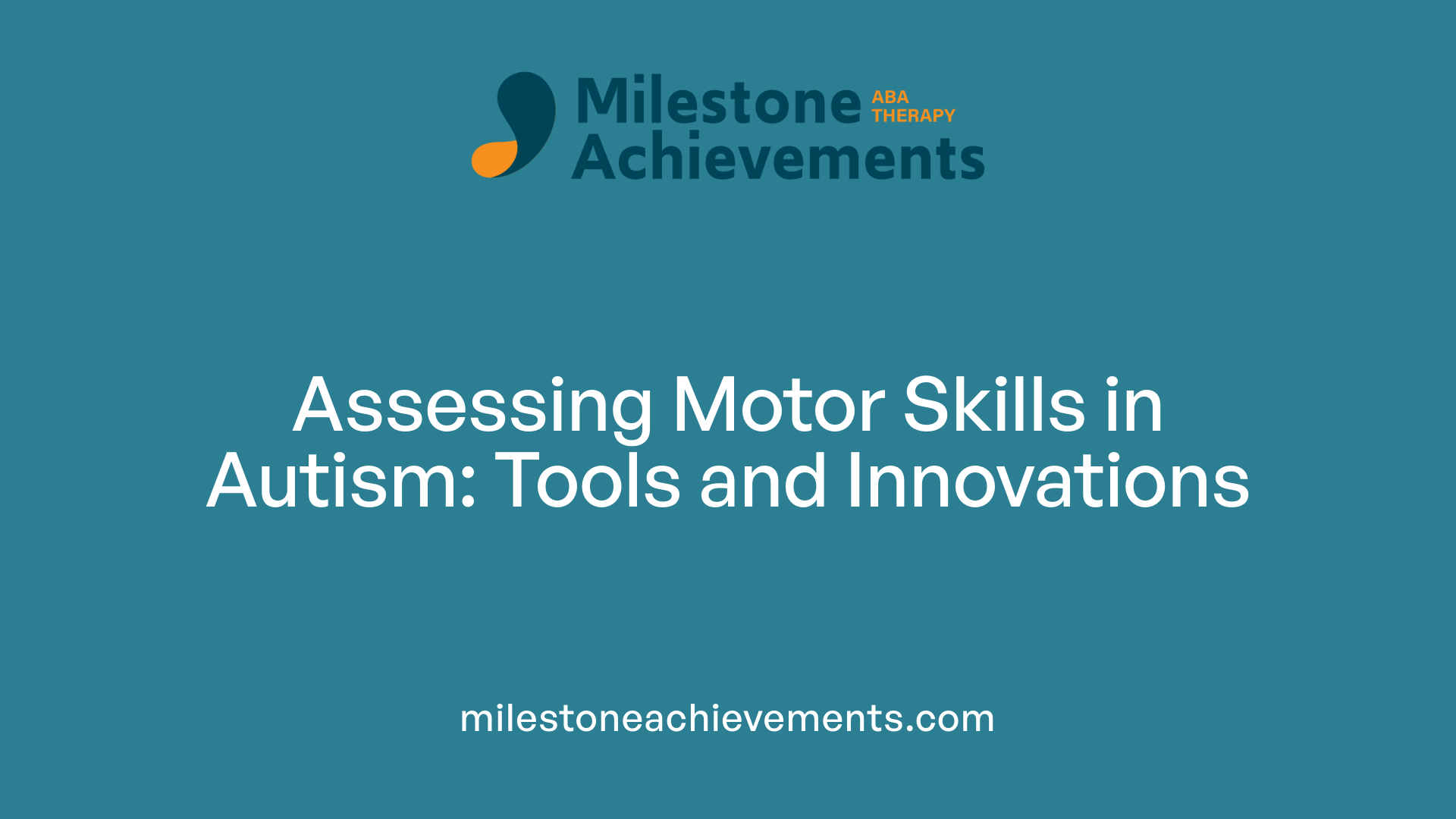
How are motor skills assessed in children and adults with autism?
Assessing motor skills in individuals with autism involves a variety of methods to capture the full scope of motor abilities and difficulties. Standardized tests like the Bruininks-Oseretsky Test of Motor Proficiency (BOT-2), the Beery-Buktenica Developmental Test of Visual-Motor Integration (VMI), and the Movement Assessment Battery for Children (MABC) are commonly used to evaluate gross and fine motor skills systematically. These tools provide scores that help identify specific deficits in coordination, strength, balance, and dexterity.
In addition to formal testing, observational methods play a crucial role. Clinicians observe children during play, daily routines, or targeted tasks to assess their motor control, imitation skills, and adaptive movements. Such checklists can help capture subtle motor differences, especially when test conditions might limit cooperation.
Emerging advanced tools have expanded assessment options. Motion sensors, pressure mats, and virtual reality environments enable precise measurement of gait, posture, and movement patterns. Handwriting analysis using digitizing tablets helps evaluate letter formation and speed. These technologies are valuable for detecting subtle impairments that might not be evident through standard tests.
Neuroimaging techniques like EEG and MRI offer insights into the neural mechanisms underlying motor difficulties. For example, decreased connectivity between visual and motor regions or atypical activity in motor planning networks can be visualized, providing a neurobiological basis for observed behaviors.
Early screening and diagnosis are vital because motor impairments often precede social and communication challenges in autism. Identifying these early signs through a combination of assessment methods can lead to timely interventions, support better developmental outcomes, and help differentiate autism from other neurological conditions.
Overall, a multi-method approach—integrating standardized assessments, observational strategies, advanced technology, and neuroimaging—provides the most comprehensive understanding of motor skills in individuals with autism. This integrated perspective guides targeted therapies and supports early intervention, which is essential for improving motor outcomes and overall development.
Interventions and Therapies for Motor Skills Enhancement
What intervention strategies and therapies can help improve motor skills in autistic individuals?
Enhancing motor skills in autistic people involves a variety of targeted intervention strategies. Occupational and physical therapies are central, focusing on developing both gross motor skills like balance, coordination, and gait, as well as fine motor skills such as handwriting, grasping, and self-care tasks.
Structured programs often include motor skill training that emphasizes core activities, including balance exercises, coordination tasks, and motor planning activities. These interventions have been shown to produce meaningful improvements, sometimes lasting for weeks or months after therapy concludes.
Incorporating engaging activities such as trampolining, swimming, climbing, and ball games can promote muscle strength and coordination. Using technology like virtual reality (VR), motion sensors, and robots offers innovative ways to encourage movement and provide real-time feedback, making therapy sessions more interactive and motivating.
Repetition and consistency are important principles in motor skill development. Short, regular practice sessions help reinforce skills, especially when tailored to individual needs.
Additionally, focusing on functional, everyday activities—such as dressing, tying shoes, and using cutlery—can boost independence and confidence. Occupational therapists often incorporate these activities into their programs, ensuring skills transfer to daily life.
Research suggests that improving motor abilities may also support improvements in social skills and communication. A comprehensive, personalized approach combining various therapies, activities, and technologies can significantly benefit autistic individuals, enabling them to participate more fully in social and daily activities.
Research Insights into Motor Signatures and Development
What have recent research findings revealed about motor signatures and development in autism?
Recent studies have uncovered that individuals with autism spectrum disorder (ASD), spanning childhood to adulthood, display unique motor patterns, often termed 'motor signatures.' These signatures include changes in how movements are timed, with slower or more variable motion, alterations in balance and gait that lead to increased sway or instability, and issues with coordination.
In children, these motor abnormalities manifest as poor motor synergy—difficulty with the smooth integration of movements—and deviations during goal-oriented tasks like reaching or walking. Notably, research demonstrates that machine learning algorithms, which analyze detailed movement data, can reliably differentiate ASD individuals from neurotypical controls by identifying patterns in their movement behaviors.
Early motor signs in infants—such as reduced arm movements, delayed standing, or atypical crawling—also suggest that motor features could serve as early biomarkers for autism. Incorporating objective tools like motion sensors, virtual reality, and electromyography has enhanced the precision of these assessments.
Furthermore, the extent of motor impairment correlates with autism severity as measured by standardized tools like the Autism Diagnostic Observation Schedule (ADOS-2) and the Autism Spectrum Quotient (AQ). These findings underscore the importance of recognizing motor signatures not just as co-occurring features, but as integral for understanding autism’s developmental trajectory.
Overall, these insights into motor development emphasize the potential for early detection through quantitative assessments, guiding targeted therapeutic approaches that can improve movement, social engagement, and overall quality of life for individuals on the spectrum.
Practical Activities to Support Motor Development
Are there practical activities to support motor skill development in children with autism?
Yes, there are many activities that can help children with autism improve their motor skills. These activities focus on both broad movements and fine hand and finger skills.
For gross motor development, engaging children in coordination exercises such as trampolining, swimming, climbing, and playing ball games like catching or kicking can be very effective. Using equipment like balance beams, hopping on one foot, or playing on playground structures can promote better balance and limb coordination.
Fine motor tasks are equally important. Activities including drawing, cutting with scissors, threading beads, playing with Play-Doh, or assembling puzzles help build manual dexterity and hand-eye coordination. Playing with small objects, manipulating tools like clothespins or tongs, and practicing gripping and releasing actions can improve finger strength and control.
Occupational therapists often incorporate sensory-based activities that specifically address motor planning difficulties. These include activities like manipulating putty or slime, using textured materials, or engaging in tactile media activities.
Consistency and patience are crucial. Regular practice of these activities, preferably in short sessions that are fun and engaging, can lead to meaningful improvements over time.
In addition to structured therapy, incorporating these activities into daily routines—such as helping with dressing, feeding, or personal hygiene—can promote generalization and practical skill development.
Overall, a combination of playful, purposeful exercises and supportive therapeutic strategies offers the best chance for children with autism to develop stronger, coordinated motor skills and enjoy greater independence.
Conclusion: The Path Forward in Autism Motor Skill Support
Why is early detection and intervention in motor skills essential?
Motor impairments are among the most common and noticeable characteristics in children with autism, affecting up to 87 percent of autistic children. These difficulties, observable in infancy, include delays in rolling, crawling, walking, and problems with coordination, strength, and balance. Early identification of motor signs allows for timely intervention, which can significantly improve motor development and overall functioning.
Interventions focused on developing gross and fine motor skills can help children participate more fully in daily activities, social interactions, and learning opportunities. Since motor skills influence communication and social engagement, addressing these challenges early can mitigate secondary issues such as social withdrawal or reduced participation in school and recreational activities.
How can a holistic and personalized approach aid development?
Customized therapy plans—incorporating physical, occupational, and movement-based therapies—are essential to cater to each child's unique needs. Incorporating activities like play, sports, yoga, and movement therapies with music can create engaging and effective intervention strategies.
Supporting families with strategies to encourage motor development at home, like modifying routines and using sensory-friendly tools, enhances therapy outcomes. Recognizing that motor skills are interconnected with other developmental domains such as cognition, language, and sensory processing, a comprehensive approach ensures balanced progress across multiple areas.
What are the directions for future research?
Advances in assessment technology—including motion sensors, virtual reality, and electromyography—offer promising avenues for more precise and early detection of motor issues. Further investigation into the neural mechanisms underlying motor difficulties could lead to innovations in targeted therapies.
Research should also explore the efficacy of emerging interventions like adapted sports or movement therapies, aiming to translate findings into practical, evidence-based practices. Developing standardized assessment protocols for motor skills in autism would improve detection and intervention planning.
How can we better incorporate motor assessments into diagnosis?
Adding a motor impairment specifier to the autism diagnosis, as suggested by current discussions, could improve recognition and resource allocation for motor difficulties. Routine screening for motor function during early developmental checkups would facilitate earlier diagnosis of motor issues, leading to timely, tailored support.
Integrating advanced assessment tools into clinical practice will provide a more detailed understanding of individual motor profiles, guiding personalized intervention programs.
How do we empower individuals with autism through tailored therapies?
Focusing on strengths and preferences, therapies can promote independence and confidence. Activities like adapted sports, arts, and movement-based therapies not only foster motor skills but also enhance social inclusion and emotional well-being.
Empowering autistic individuals with tools, strategies, and opportunities to improve motor control supports their participation in community life, education, and employment. This approach underscores the importance of patience, persistence, and supportive environments to help each person reach their full potential.
| Aspect | Focus | Benefits |
|---|---|---|
| Early Detection | Recognizing signs in infancy | Timely intervention, better outcomes |
| Personalized Therapy | Custom activities & movement practices | Improved motor, social, and cognitive skills |
| Technological Advances | Motion sensors, VR, electromyography | Accurate assessment and targeted treatment |
| Family & Community | Support strategies & inclusive activities | Greater participation & confidence |
| Future Research | Neural mechanisms & intervention efficacy | Innovation and evidence-based practice |
Enhancing motor skills in autism is fundamental to supporting overall development, independence, and well-being. By advancing detection, personalized approach, and ongoing research, we can build a more inclusive future where every individual has the opportunity to thrive.
Shaping Future Directions in Autism and Motor Skills
Addressing motor challenges in autism requires a multidimensional approach that emphasizes early detection, personalized intervention, and ongoing research. As our understanding of the neurological basis improves, incorporating sophisticated assessment techniques and innovative therapies will be pivotal. Supporting motor development not only enhances physical health but also opens pathways to improved social, cognitive, and emotional outcomes, underscoring the importance of a holistic strategy in autism care.
References
- Motor difficulties in autism, explained | The Transmitter
- Motor problems in autism: Co-occurrence or feature? - PMC
- Autistic Children and Motor Skills
- Motor Skills and Executive Function in Autism
- Motor Development in Children With Autism Spectrum Disorder - PMC
- How Does Autism Affect Motor Skill Development? | Little Feet Therapy
- A scoping review of the motor impairments in autism spectrum disorder
- Motor signature of autism spectrum disorder in adults without ...
- Beyond words: an investigation of fine motor skills and the verbal ...
- 11 Fabulous Fine Motor Activities for Autism - Gympanzees


Partner with us on your child's journey
Milestone Achievements offers evidence-based ABA therapy to help children with autism reach their full potential. Together we’ll set meaningful goals and celebrate progress every step of the way.
Start ABA Services Today


